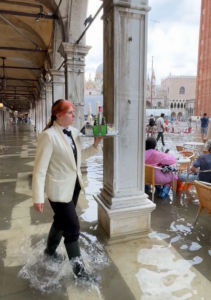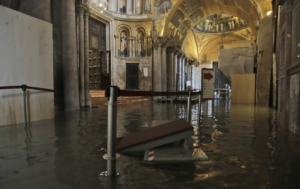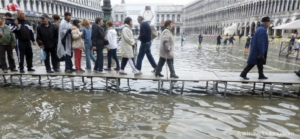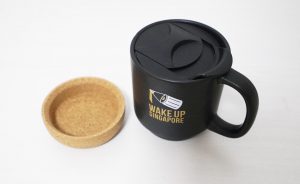Flooding about a hundred times a year, the floating city, Venice, has been battling increasing water levels for centuries. During the winter months, starting from October until late winter, flooding due to both man-made and natural causes make locals and tourists adapt to the predicament in swift and creative ways.
A TikTok video by the user @/tiktokvenezia shows a cafe on St. Mark’s Square, Venice, where waitresses are seen wading through the flooded area to serve customers who appear unfazed by the risen water levels. Donning plastic boots, residents nonchalantly live through their day, enjoying the breezy weather.


Acqua Alta in Venice
‘Acqua Alta,’ or ‘high water,’ is an inescapable event in Venice – a poignant reminder of both the city’s historical splendor and its ever-increasing vulnerability. The phenomenon occurs when a mix of high tides and low atmospheric pressure floods Venice’s streets, leaving St. Mark’s Square, narrow alleyways, and even shopfronts submerged under several feet of water.

A centuries-old occurrence, Acqua Alta is manageable by Venetians, but the effects have intensified in recent years due to rising sea levels and climate change. Streets in the city transform into shallow rivers, and while measures are put into place to prevent damages to locals’ livelihoods, the water seeps into cracks, creeping into basements, damaging merchandise, and leaving corrosion from saltwater in its wake: destroying ancient architecture in the historical city.
How the City Learnt to Adapt
Locals trudge along the flooded streets in rubber boots, whilst businesses employ the use of waterproof barriers to protect their stores. However, while these methods are not consistently effective despite efforts to keep water at bay, locals have had centuries to adapt, and they do so with quiet efficiency. Shopkeepers simply mop up after the floodwaters recede, cafes move their tables and chairs indoors, and gondoliers anchor their boats temporarily.

For tourists, the phenomenon of ‘high water’ becomes a bizarre chapter in their journey within Venice. Warnings are issued on certain days, and the city is traveled on raised platforms called ‘passerelle,’ set up by local authorities. In extreme cases, public transport comes to a halt, and tourists are forced to move to higher ground.
Unsafe Waters
While it may be tempting for tourists to jump in and take pictures, they must navigate the waters of Acqua Alta with caution. The waters are reported to be ‘very dirty,’ as garbage floats through the roads, carrying along debris from stores, garbage cans, and piazzas.

One must be wary of contracting bacterial infections from the waters, and the stench emanating naturally acts as a deterrent to those even imagining swimming or walking barefoot in the waters. Additionally, the saltwater that permeates the city erodes brickwork and stone foundations, threatening the integrity of Renaissance infrastructure.
Despite being fascinating to experience, and exhilarating to view on our screens, living with Acqua Alta for Venetians shows their resilience as the city adapts to survive despite rising waters threatening its future.
Watch the video here:
@tiktokvenezia Acqua alta a Venezia #venice #venezia #tiktokvenezia #italia #italy
More from Wake Up Singapore:-
The Rise of Phone Bot Farms: A Shortcut to Social Media Fame
Man Rescues Trapped Rabbits from Raging Fire, Winning Hearts Online
“No, We Go Home Now”— Maid Tells Elderly Man After Ignoring His Requests
If you have a story or a tip-off, email admin@wakeup.sg or get in touch via Whatsapp at 8882 5913.
Since you have made it to the end of the article, follow Wake Up Singapore on Telegram!
Wake Up Singapore is a volunteer-run site that covers alternative views in Singapore. If you want to volunteer with us, sign up here!
If you can, please do consider buying a mug or two to support Wake Up Singapore’s work!







